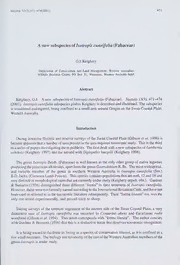Table Of ContentNuytsia 13(3):471-474(2001) 471
AnewsubspeciesofIsotropiscuneifolia (Fabaceae)
G.J.Keighery
Department of Conservation and Land Management, Western Australian
Wildlife Research Centre, PO Box 51, Wanneroo, Western Australia 6065.
Abstract
Keighery, G.J. Anew subspeciesofIsotropis cuneifolia (Fabaceae), Nuytsia 13(3): 471—474
(2001). IsotropiscuneifoliasubspeciesglabraKeigheryisdescribedandillustrated.Thesubspecies
is consideredendangered, beingconfinedto asmall areaaroundGingin onthe SwanCoastalPlain,
WesternAustralia.
Introduction
During intensive floristic andreserve surveys ofthe Swan Coastal Plain (Gibson etal. 1994) it
becameapparentthatanumberoftaxapresentinthearearequiredtaxonomicstudy. Thisisthethird
inaseriesofpapersinvestigatingtheseproblems. ThefirstdealtwithanewsubspeciesofLambertia
echinata (Keighery 1997) andthe secondwithDiplopeltis huegelii (Keighery 1998).
The genusIsotropisBenth. (Fabaceae) iswellknownas theonlyothergroup ofnative legumes
producingthepoisonousalkaloides,apartfromthegenusGastrolobiumR.Br. Themostwidespread,
and variable member of the genus in southern Western Australia is Isotropis cuneifolia (Sm.)
B.D.Jacks.(CommonLambPoison). Thisspeciescontainspopulationsthataren=6, 12and 18and
verydistinctivemorphologicalracesthatarecurrentlyunderstudy(Keigheryunpub.obs.). Gardner
& Bennetts (1956) distinguished three different “forma” in their treatment ofIsotropis cuneifolia.
However,thesewerenotformallynamedaccordingtotheInternationalBotanicalCode,andhavenot
beenusedorreferredtointhetaxonomicliteraturesubsequently. Their“formalineata”ms. wasthe
only one tested experimentally, and proved toxic to sheep.
During surveys ofthe remnant vegetation ofthe eastern side ofthe Swan Coastal Plain, avery
distinctive race of Isotropis cuneifolia was recorded in Casuarina obesa and Eucalyptus rudis
woodland(Gibsonefa/. 1994). Thistaxoncorresponds with “forma Theauthorconcurs
withGardner& Bennetts (1956)thatthisisadistinctivetaxonthatdeservestaxonomic recognition.
Itisbeingnamedtofacilitateitslistingasaspeciesofconservationinterest, asitisconfinedtoa
fewsmallremnants. ThebiologyandtaxonomyoftherestoftheWesternAustralianmembersofthe
genusIsotropisis understudy.
472 Nuytsia Vol. 13, No. 3 (2001)
Taxonomictreatment
Isotropiscuneifoliasubsp. glabraKeighery,subsp. nov.
Differt aIsotropis cuneifoliea subsp. cuneifoliea foliis etramulis omnino glabris.
Typus: Gingin business road, 6 km south of Gingin, Western Australia, 16 September 1987,
G.J. Keighery9242 (holo: PERTH 02869365;iso:CANB).
Aclonalsoft-woodedshrub,to20cmtalland2macross,dyingbacktotheundergroundstemin
mm
summer, andresproutingin winter. Stemaboveground 2-3 wide,glabrous,basalthirdtinged
red, uppershining green. Basalleavessessile (orgradually tapering into apetiole), trident-shaped,
mm mm
distinctly 2-lobed when mature, 76-88 long, 8-9 across sinus, green, shining, glabrous.
mm mm
Stipules17-23 long,green,glabrous. Pei/ice/580-98 long,glabrous. Bracieo/e5immediately
mm
belowcalyx,linear,brown. Ca/yj:brown,glabrous,lobes11-13 long,lowerlobesobovate-acute,
mm
upperlobestwo-lobed. Standard26-28 wide,eyeyellow,surroundedbyaredcoronathenyellow
aroundmargins,reversered. Wing514-17mmlong,red. /(Tee/redtoalmostblack. Gvao'green,densely
mm mm
hairy.Legumerecurved,cylindrical,23-30 long,narrowedatbaseintoastipe5-8 long,brown,
mm
withscatteredappressedhairs. Seedsreniform,c. 1 wide,brown,surfacewithanopenreticulate
pattern. (Figure 1)
Specimens examined. WESTERN AUSTRALIA: Gingin, W.E. Blackall 2962 (PERTH); Gingin,
29Aug. 1924,Came&Gardners.n.(PERTH);45milepeg[72km]onGinginroad,H.Demarz3928
(PERTH, KPBG); Cowalla Rd, 8 miles [13 km] N of Gingin to Guilderton road, 8 Dec. 1965,
A.S.Georges.n.(PERTH);YurineSwampNatureReserve,G.J.Keighery14976(PERTH); EofLake
BambunReserve,20Nov. 1991,B-d. Keigherys.n. (PERTH).
Distribution andhabitat. Knownfromtheeastern sideofthe Swan Coastal Plain, extending about
20km northand southofGingin, whichis 80kmnorthofPerth. Grows underCasuarina obesa or
Eucalyptusrudislowwoodlandonwinter-wetflats,usuallyinredclayorironstoneorsandyclayover
ironstone. Likeothermembersofthisspecies,plantsdiedowntoapersistentrootstockoversummer.
Newstemsareproducedafterthefirstrainsinautumnorwinter.
Floweringperiod. AugusttoOctober.
Conservationstatus. CALMConservationCodes forWesternAustralianFlora: Priority Two. One
smallpopulationisknown withinaconservationreserve. Otherpopulations are also small.
Notes. This subspecies differs from all other variants of Isotropis cuneifolia in being completely
glabrous, and in the long, thin shining green leaves. It is separated ecologically from the typical
subspecieswhichgrowsonwelldrainedsitesontheSwanCoastalPlainandadjacentDarlingRange.
Therearethreeotherpotentialsubspecifictaxainthespecies,occurringbetweenGeraldtonandShark
Bay, in the southern wheatbelt and along the southcoast.
G.J. Keighery, A new subspecies of Isoptropis cuneifolia 473
Figure 1. Flowering branchlet of hotropis cuneifolia subsp. glabra. Scale bar = 20 mm. Drawn from
G.J. Keighery 14976 (PERTH).
474 Nuytsia Vol. 13, No. 3 (2001)
References
Gardner, C.A.G. & Bennetts, H.W. (1956). ‘The Toxic Plants ofWestern Australia.” (Western Australian Newspapers
Ltd: Perth.)
Gibson, N., Keighery, B.J., Keighery, G.J., Burbidge, A.H. & Lyons, M.N. (1994). A Floristic Survey ofthe southern
Swan Coastal Plain. Unpublished Report for the Australian Heritage Commission.
Keighery, G.J. (1997). A new subspecies of Lambertia echinata (Proteaceae). Nuytsia 11: 283-284.
Keighery, G.J. (1998). Taxonomy of Diplopeltis huegelii (Sapindaceae). Nuytsia 12: 289-291.

